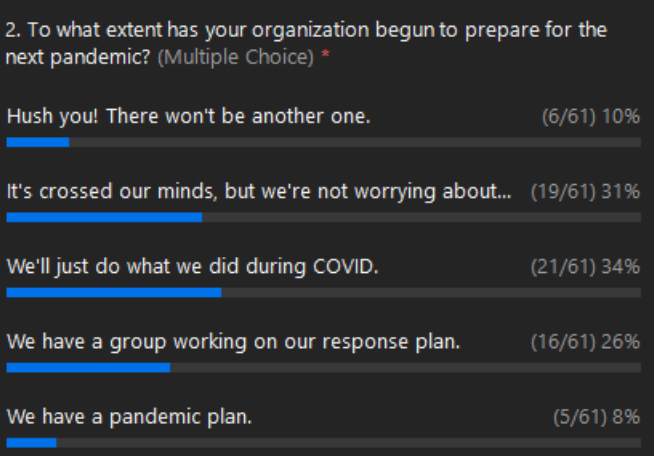What is Giving Compass?
We connect donors to learning resources and ways to support community-led solutions. Learn more about us.
Search our Guide to Good
Start searching for your way to change the world.
The COVID-19 pandemic changed the giving landscape over the past three years and led to positive trends in philanthropy. To help funders consider how to embed ongoing pandemic responses within their normal operations, the Center for Disaster Philanthropy (CDP) hosted a webinar titled COVID-19 Year Four: Implications for Philanthropy.
The webinar discussed the difficult nature of the intersection of COVID-19 with disasters and complex humanitarian emergencies, as well as the damage that COVID-19 wrought beyond the immediate morbidity and mortality, including poverty, hunger, and mental health. Webinar attendees responded to a live poll regarding their preparations for the next pandemic, revealing that most do not have a pandemic plan.

Patty McIlreavy, CDP’s president and CEO, moderated the discussion. Panelists included Amy K. Liebman, chief program officers at Migrant Clinicians Network; Alyson Niemann, executive director for Mindful Philanthropy; and Julien Schopp, vice president of humanitarian policy and practice at InterAction.
Liebman began by highlighting the risks clinicians took to provide care during the pandemic, with this population three times more likely to be infected than the general population. Liebman said other populations disproportionately impacted by COVID-19 included farm and food workers who received few protections and Latino and Black communities with higher case and death rates than white communities.
Mental health conditions were already emerging needs before the pandemic, but COVID-19 exacerbated the situation. Niemann described increased anxiety and depression globally in the first year of the pandemic and increased substance use and overdoses. Contributing factors included grief and trauma, social isolation, stress, and loss of milestones.
For members of InterAction, an alliance of international non-governmental organizations in the U.S., there was no remote work option since they are providing life-saving humanitarian assistance in some of the most challenging contexts globally. Schopp said a lack of personal protective equipment affected humanitarians, and COVID-19 restrictions impacted travel and surge capacities. A positive development was the emphasis on funding local organizations.
McIlreavy encouraged funders to maintain the generosity seen during the pandemic to support current overlapping crises and significant disaster recovery and humanitarian needs. Looking forward, Liebman said funders could focus on getting hyper-local with their support, invest in community health workers, build trust with partners, and advocate for workplace protections.
Echoing Liebman, Schopp stressed the importance of funders working with more local organizations and strengthening relationships with them. He also said that while humanitarians focused on logistics and supplies during the pandemic, they must also work on combatting health disinformation, which is something funders can support. Niemann’s message to funders was to help strengthen mental health systems and integrate mental health into their funding strategy using the following considerations.
- Social connectedness and strong relationships are key protective factors.
- Support programs where people find connection and identity, e.g. through religion, culture, athletics, and recreation.
- Support the integration of mental health into those spaces.
- e.g. youth-serving organizations, culturally-led mental health programs
The webinar concluded with McIlreavy encouraging attendees to remember that disasters need ongoing attention, that supporting root causes is critical and to follow the pandemic lessons.
Watch the full webinar at the Center for Disaster Philanthropy.
Categories:
- Philanthropy (Other)
- Global
- Disasters